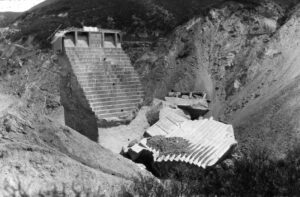
 For as long as there have been dams to control water, there have been problems with those same dams. The Saint Francis dam in the San Francisquito Canyon in California was a concrete gravity dam, that was built between 1924 and 1926. A gravity dam is a dam constructed from concrete or stone masonry and designed to hold back water by using only the weight of the material and its resistance against the foundation. Gravity dams are designed so that each section of the dam is stable and independent of any other dam section…theoretically. The Saint Francis had only been standing two years, when it suddenly failed in 1928. The failure was catastrophic, and the flood that followed killed at least 431 people, in what is considered to have been one of the worst American civil engineering disasters of the 20th century and the third-greatest loss of life in California history. How could a dam that was only two years old fail so soon and so horribly.
For as long as there have been dams to control water, there have been problems with those same dams. The Saint Francis dam in the San Francisquito Canyon in California was a concrete gravity dam, that was built between 1924 and 1926. A gravity dam is a dam constructed from concrete or stone masonry and designed to hold back water by using only the weight of the material and its resistance against the foundation. Gravity dams are designed so that each section of the dam is stable and independent of any other dam section…theoretically. The Saint Francis had only been standing two years, when it suddenly failed in 1928. The failure was catastrophic, and the flood that followed killed at least 431 people, in what is considered to have been one of the worst American civil engineering disasters of the 20th century and the third-greatest loss of life in California history. How could a dam that was only two years old fail so soon and so horribly.
Not everyone was in favor of the dam, which as it turns out was only the second concrete dam to be designed and built by the Bureau of Water Works and Supply. The first was the nearly “dimensionally identical” Mulholland Dam. That dam construction was had begun one year earlier. The design of the Saint Francis Dam was actually an adaptation of the Mulholland Dam. The designer made modifications to suit the site, but can the same design work in two different locations. I suppose it could in the case of a building, but a dam would need to be designed with the specific soil type, terrain structure, and even earthquake fault lines in mind. The adaptations were supposed to take stress factors into consideration. Most of the design changes and computation figures of the possible stress factors for the Saint Francis Dam came from the work of the plans and formulas which had been used in the constructing of the Mulholland Dam. This work was done by the engineering department within the Bureau of Water Works and Supply.
The dam was built to serve the growing water needs of the city of Los Angeles. The plan was to create a large regulating and storage reservoir that was to be an important part of the Los Angeles Aqueduct. Unfortunately, the defective soil foundation of the area, and the design flaws of the dam led to the dam’s collapse just two 
 years after its completion. Two and a half minutes before midnight on March 12, 1928, the Saint Francis Dam catastrophically failed. Its failure caused the death of 431 people, and it ended the career of William Mulholland, the general manager and chief engineer of the Bureau of Water Works and Supply (now the Los Angeles Department of Water and Power).
years after its completion. Two and a half minutes before midnight on March 12, 1928, the Saint Francis Dam catastrophically failed. Its failure caused the death of 431 people, and it ended the career of William Mulholland, the general manager and chief engineer of the Bureau of Water Works and Supply (now the Los Angeles Department of Water and Power).


Leave a Reply